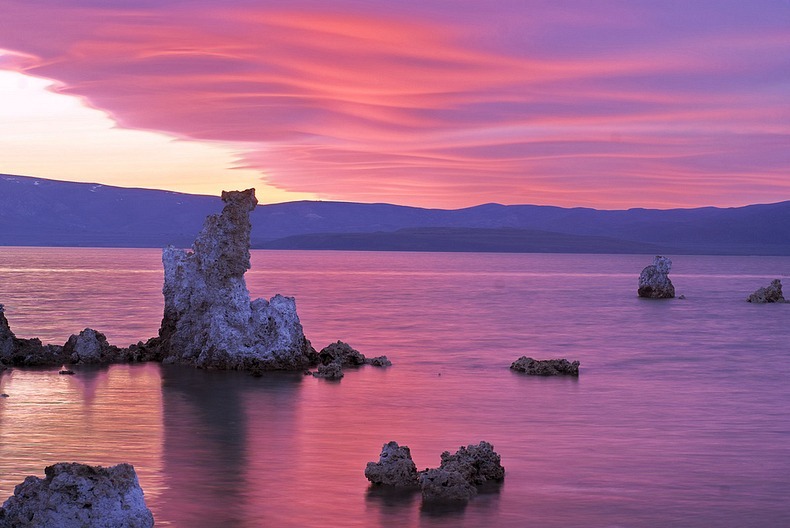Mono Lake is a shallow salt water lake located in the high desert on the eastern slope of the Sierra Nevada Mountains, in California in the United States. The lake has no outlet to the ocean causing high levels of salts to accumulate in the waters. As a consequence of its high salinity, no fish live in Mono Lake, but there are plenty of brine shrimp that thrive in its waters. Over two million annual migratory birds use Mono Lake as a stop over and resting place as they fly to South America or the tropical oceans. They feed on the shrimps, lay eggs and hatch their young ones here.
The most unusual feature of Mono Lake are its dramatic tufa towers emerging from the surface. These rock towers form when underwater springs rich in calcium mix with the waters of the lake, which are rich in carbonates. The resulting reaction forms limestone. Over time the buildup of limestone formed towers, and when the water level of the lake dropped the towers became exposed.
But the drop in surface level was not a natural phenomenon. It started in 1941 when the city of Los Angeles began diverting the streams that fed Mono Lake. So much water was drawn away from the lake that the surface level of Mono Lake fell by 45 feet. By 1982 the lake was reduced to 37,688 acres (15,252 ha) having lost 31 percent of its 1941 surface area. As a result, alkaline sands and the once submerged tufa towers became exposed and a land bridge between the shoreline and an island was formed. The island served as a major breeding area for migratory birds. Until now, the island was a safe haven protected by waters all around, but the newly formed land bridge invited predators such as coyotes to the island, who fed on eggs and chicks forcing the breeding colony of birds to abandon the site.
In addition to migratory birds, several other species spend months nesting at Mono Lake, among which are California gulls. After the land bridge to the Negit Island became exposed in the late 1970s, the California gulls have also moved to nearby islets and have established new, and less protected, nesting sites.
A study conducted in 1988 predicted that if the drying of Mono Lake was allowed to continue, by 1999 the salinity of the lake would increase to a level where the productivity of the brine shrimp would begin to decline. Finally by 2012, the existing lake ecosystem could cease to function because the lake salinities would reach such high levels that brine shrimp and brine flies could no longer survive, thus depriving 1.3 million birds of their food source at the lake.
Based on the report, in 1994, the California State Water Resources Control Board issued an order to protect Mono Lake. The goal is to return the lake to the level of 6,392 feet above sea level. As of July 2012, Mono Lake was at 6,383.3 feet above sea level but frequent droughts in the region have made achieving the goal more and more difficult.
Also read: The Disappearing Aral Lake and the Ship Graveyard of Moynaq

NASA Landsat 7 image. Photo credit




























Back in '77 I brought home a piece of a Tufa tower which capped part of the background wall of Tufa towers in Pink Floyd's Wish You Were Here album, the Summer after the album release, when I was 17, and 4 years before they became protected in 1981.
ReplyDeleteIt's interesting to own something from a Pink Floyd album picture as obscure and avant garde as that pic from the postcard & inner poster album art.